CHŌ WAKUSEI SENKU META FIGHT
( Blaster Master )
|
|
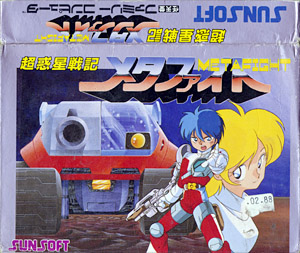
|

|
|
超惑星戦記 メタファイト
©1988 Sunsoft
©Tokai Engineering
Release: 1988-06-17 (¥5300)
Cartdridge STEC-MF
Platform/Action
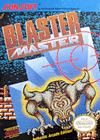
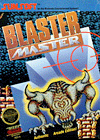
|

Released in America as
BLASTER MASTER
( NES-VM-USA )
|
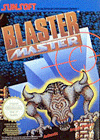

|
Released in Europe as
BLASTER MASTER
( NES-VM-XXX )
|
|
Chō Wakusei Senki Meta Fight (aka Blaster Master) is a side scrolling
action game developed by Tokai Engineering and Sunsoft. In the year 2052,
the evil and powerful emperor Goez is on a path to global domination. In the
Epsilon Galaxy, on planet Sophia the 3rd, a group of scientists manages to
flee to safety on Nora, a nearby satellite. There, they quickly design and build
the Metal Attacker, a versatile and heavily armed combat vehicle which,
they believe, will be capable of countering the invasion. Furthermore, the ace pilot
Kane Gardner is assigned to take control of the mobile battle tank and to defeat
the invading forces of Goez. The base gameplay mechanics is what distinguishes
Meta Fight from most other action games released at the time. It features two modes
of play intimately intertwined with the game flow - at first, Kane pilots the
Metal Attacker tank and works his way through underground tunnels, taking down
enemies and collecting items such as Life capsules. The tank is equipped with a
laser canon that can fire forwards or upwards, and the armored vehicle can also jump
from platforms to platforms, or fire a sweeping barrage of missiles. But, at anytime
during the game, the player can leave the tank behind and carry on his journey on foot.
This feature is at the core of the gameplay and maze-like chambers that only Kane
can access (and which use an overhead view) are scattered throughout the game and hide
special bonuses as well as the game's vicious bosses. Kane is obviously really
weak when outside the tank, and the player should only release him when close to a
chamber - although Kabe can swim, he however takes a lot of damage, dies if he
falls from too great a height and his firepower is ridiculously underpowered. Once a
boss is defeated, the player receives an upgrade to the tank ranging from a more powerful
Crusher Beam that can pierce blocks, to a powerful hovering function allowing him
to fly over short distances. Meta Fight consists of eight large levels, and although
the game starts off quite linear, later levels require backtracking through areas already
played through.
|
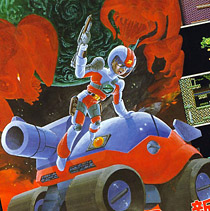 Chō Wakusei Senki Meta Fight (better known as Blaster Master)
is the first episode of a long series of games published by Sunsoft. Interestingly,
the game was more popular in the United States (and in the rest of the world) than
its native Japan, and this unkind twist of fate may explain why some of the sequels
that followed simply tried to cash in on the success of the first game. Read on. The first
sequel was called Blaster Master Boy (aka Blaster Master Jr. in Europe)
and was released in 1991 for the Game Boy system, and this exclusively in the
United States and Europe. However, the original Japanese Game Boy
game from which Blaster Master Boy is based on has nothing to do with the first
Meta Fight! It was in reality called Bomber King 2, itself sequel of a
Bomberman spin-off originally released for the Famicom by Hudson Soft!
This certainly explains why the tank is nowhere to be seen in this version... But things
didn't stop here! A new game called Blaster Master II was then specifically developed
for the US market - the game, developed by the British game company
Chō Wakusei Senki Meta Fight (better known as Blaster Master)
is the first episode of a long series of games published by Sunsoft. Interestingly,
the game was more popular in the United States (and in the rest of the world) than
its native Japan, and this unkind twist of fate may explain why some of the sequels
that followed simply tried to cash in on the success of the first game. Read on. The first
sequel was called Blaster Master Boy (aka Blaster Master Jr. in Europe)
and was released in 1991 for the Game Boy system, and this exclusively in the
United States and Europe. However, the original Japanese Game Boy
game from which Blaster Master Boy is based on has nothing to do with the first
Meta Fight! It was in reality called Bomber King 2, itself sequel of a
Bomberman spin-off originally released for the Famicom by Hudson Soft!
This certainly explains why the tank is nowhere to be seen in this version... But things
didn't stop here! A new game called Blaster Master II was then specifically developed
for the US market - the game, developed by the British game company
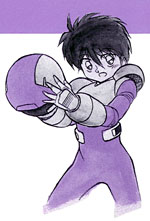 Software Creations, was exclusively released for the Sega Genesis in 1993,
and is a shameful disgrace to the original game. But things got better, and the real true
sequel to Meta Fight was finally released for the Game Boy Color in 2000 - the
game, called Meta Fight EX in Japan (aka Blaster Master Enemy Below in
the west), looks like a remake of the original Famicom game at first glance (same stage
themes, same music, same graphics), but it is an entirely different game.
Blaster Master
(aka Blaster Master Blasting Again in the west) then followed for the Playstation
in 2000 - it was the first game in the series to use full polygonal 3D and was a sort of a reboot
for the franchise (the game was called Blaster Master, and this even in Japan!).
Finally, Blaster Master Overdrive was released for the Wii (WiiWare) in
2010 (US and Europe only though), and although the game follows the same formula
established by the first game, Sunsoft managed to bring new and more modern ideas to the table.
Software Creations, was exclusively released for the Sega Genesis in 1993,
and is a shameful disgrace to the original game. But things got better, and the real true
sequel to Meta Fight was finally released for the Game Boy Color in 2000 - the
game, called Meta Fight EX in Japan (aka Blaster Master Enemy Below in
the west), looks like a remake of the original Famicom game at first glance (same stage
themes, same music, same graphics), but it is an entirely different game.
Blaster Master
(aka Blaster Master Blasting Again in the west) then followed for the Playstation
in 2000 - it was the first game in the series to use full polygonal 3D and was a sort of a reboot
for the franchise (the game was called Blaster Master, and this even in Japan!).
Finally, Blaster Master Overdrive was released for the Wii (WiiWare) in
2010 (US and Europe only though), and although the game follows the same formula
established by the first game, Sunsoft managed to bring new and more modern ideas to the table.
|
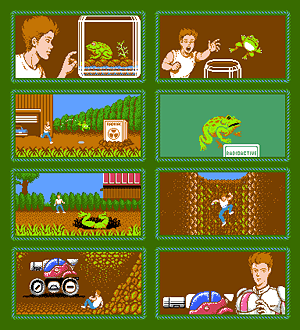 Both Japanese and Western versions of Chō Wakusei Senki Meta Fight
are identical in gameplay, but the story was curiously mangled and changed in the American
and European versions. While the original Japanese story wasn't the most original
ever (evil emperor taking over the galaxy), I thought that it served the game well and explained
pretty much everything. But Blaster Master (the localized version of Meta Fight)
went another route - the game takes place in New York and is centered around a teenage boy
called Jason Frudnick. One day, Fred, his pet frog, jumps out of his tank and escapes
into the backyard. There, the animal finds a buried radioactive container and grows huge, and then
jumps into a large hole in the ground leading to mysterious underground caverns. While trying to
reach for his pet, Jason falls into the hole and discovers an armored tank called
Sophia The 3rd - he quickly takes over the controls of the vehicle and decides to investigate the newly
discovered passageway. There he fights through swarms of radioactive mutants and eventually saves
fred. Huh ?... Although I sort of get the mild reference to Alice in Wonderland (where
the white rabbit was replaced by a pet frog), I still think that's some seriously
twisted story telling... Anyway, because of it, the Western version of the game features a
new introduction sequence and a slightly different ending. Interestingly, soon after
Blaster Master was released in the United States, a novel (part of the
Worlds of Power series) written by A.L. Singer (aka Peter Lerangis) describes
the game's story in more details, and introduces Eve (who will become Jason's wife)
and a friend named Alex Bufoni. And all this backstory was even later referenced in the
Playstation sequel (aka Blaster Master Blasting Again) released in 2000.
Both Japanese and Western versions of Chō Wakusei Senki Meta Fight
are identical in gameplay, but the story was curiously mangled and changed in the American
and European versions. While the original Japanese story wasn't the most original
ever (evil emperor taking over the galaxy), I thought that it served the game well and explained
pretty much everything. But Blaster Master (the localized version of Meta Fight)
went another route - the game takes place in New York and is centered around a teenage boy
called Jason Frudnick. One day, Fred, his pet frog, jumps out of his tank and escapes
into the backyard. There, the animal finds a buried radioactive container and grows huge, and then
jumps into a large hole in the ground leading to mysterious underground caverns. While trying to
reach for his pet, Jason falls into the hole and discovers an armored tank called
Sophia The 3rd - he quickly takes over the controls of the vehicle and decides to investigate the newly
discovered passageway. There he fights through swarms of radioactive mutants and eventually saves
fred. Huh ?... Although I sort of get the mild reference to Alice in Wonderland (where
the white rabbit was replaced by a pet frog), I still think that's some seriously
twisted story telling... Anyway, because of it, the Western version of the game features a
new introduction sequence and a slightly different ending. Interestingly, soon after
Blaster Master was released in the United States, a novel (part of the
Worlds of Power series) written by A.L. Singer (aka Peter Lerangis) describes
the game's story in more details, and introduces Eve (who will become Jason's wife)
and a friend named Alex Bufoni. And all this backstory was even later referenced in the
Playstation sequel (aka Blaster Master Blasting Again) released in 2000.
|
Teaser text copied from the American version:
Mega Graphics! Mega Action!
The New York sewers were never like this!
You've fallen down a hideen manhole into a world of creatures
so terrifying they'd scare the rats away. You can panic
and perish, or blast your way through an endless maze of
tunnels, searching for the secret passages to your escape.
And that's the easy part. Because the Masters of the
Cavers lay waiting - prehistoric creatures so powerful, so
gigantic, they literally fill your screen! So load your
arsenal and get ready for Blaster Master.
|
Game Staff (Copied from the end credits) :
|
Director
H. Higasiya
K. Kitazumi
Manager
K. Yoshida
|
|
Game Design
Fanky.
And Others
Character Design
Fanky.
Art Design
PGM-F1
|
|
Music Composer
Naoki Kodaka
Sound Program
Marumo
Program
Senta
Kanz
|
|
Special thanks to
Moriken
Chiao
The END
Very Thanks..!!
Presented By...
SUNSOFT
|
|
G
O
O
D
I
E
S
|
|
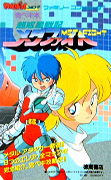
Japanese Guidebook
|
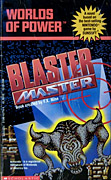
American novel book
|
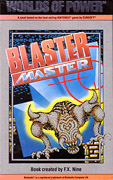
Australian novel book
|
|
|
O
M
A
K
E
|
|
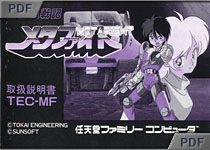
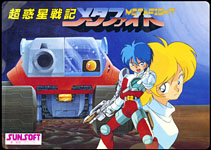
|
|
|
Click on picture to enlarge |
|
|
|
LK

|
|
Add your Pov here !
|
P
O
V
s
|
|
A few Famicom games have tried to break the mold and to combine genres - some
have been incredibly successful at it (such as Goardic Gaiden), whereas
others haven't (Super Star Force comes to mind).
And Meta Fight is definitively a game
that ticks all the right boxes. The graphics are excellent, the attention to detail is
exquisite and the soundtrack is wonderful. The tank is incredibly responsive and a
pleasure to drive, and the "double play" and the way how the game switches to an overhead
perspective when exploring the various chambers on foot is pure genius and seamlessly
integrated with the gameplay. And although the game starts out fairly linear, things quickly
become more complicated and you will often have to return to previously visited areas in order
to proceed (in a way similar to Metroid or Zelda). The game is quite long and
difficult, and the lack of password/save option means that you have to finish it in one
sitting though... tricky. But all in all, I wonder why Mega Fight never became a megahit
in Japan (although it was fairly popular in the rest of the world) - it is definitively
one of the best action game ever released for the Famicom system, and a must have.
|
|
|
|